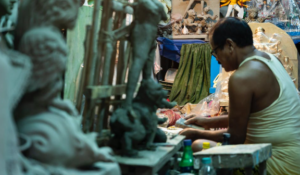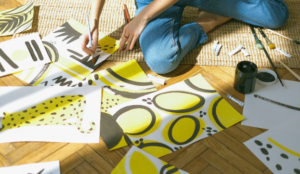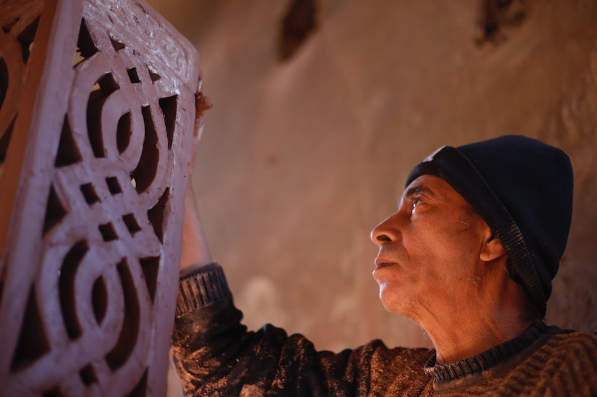For many, the world of art and creative expression is intrinsically linked to visual perception. However, for individuals with low vision, navigating this artistic landscape can present unique challenges. This is where the transformative power of clay sculpting emerges, offering a tangible and accessible avenue for self-discovery and artistic exploration.
Unlike traditional art forms that rely heavily on sight, clay sculpting engages the sense of touch, unlocking a world of creative possibilities. Through the tactile manipulation of clay, individuals with low vision can explore textures, shapes, and forms, fostering a deeper connection to their inner world and providing a unique outlet for self-expression.
This first session delves into the introductory details of clay sculpting for people with low vision, igniting your curiosity and setting the stage for a captivating journey. We will explore the key benefits, potential adaptations, and inspiring examples to demonstrate the transformative power of clay sculpting in defying limitations and unlocking creative potential.
So, prepare to embark on a journey of discovery, where limitations become stepping stones and creativity knows no bounds. In the next session, we will delve deeper into the meaning and significance of clay sculpting for individuals with low vision, revealing the hidden potential and empowering possibilities.

Table Of Contents
- 1 Unveiling the Meaning – Clay Sculpting as a Language of the Soul
- 2 Here are some key aspects that define the meaning of clay sculpting for people with low vision:
- 3 Embracing Creativity – Exploring Techniques and Adapting for Success
- 4 Techniques to Embark on Your Artistic Journey:
- 5 Adapting Techniques for Enhanced Accessibility:
- 6 Resources and Inspiration for Your Creative Path:
- 7 Tips for a Rewarding Clay Sculpting Experience:
- 8 Reflecting and Moving Forward – Conclusions and FAQs about Clay Sculpting for People with Low Vision
- 9 Key Takeaways:
- 10 Frequently Asked Questions (FAQs):
- 11 Q: Do I need artistic experience to participate in clay sculpting for people with low vision?
- 12 Q: What type of clay should I use?
- 13 Q: What tools do I need?
- 14 Q: How often should I practice clay sculpting?
- 15 Q: Do I need to find an art therapist or instructor?
- 16 Conclusion:
- 17 Additional Resources:
Unveiling the Meaning – Clay Sculpting as a Language of the Soul
In this second session, we move beyond the surface of clay sculpting and explore its profound meaning and significance for individuals with low vision. We will uncover the multi-layered benefits this art form offers, transforming it from a mere hobby to a powerful tool for self-expression, emotional release, and personal growth.
Here are some key aspects that define the meaning of clay sculpting for people with low vision:
1. Tactile Language: Clay serves as a powerful language for individuals with low vision, allowing them to bypass the limitations of sight and communicate their emotions, experiences, and inner world through tangible creations. The act of shaping and molding the clay becomes a form of non-verbal expression, revealing the intricate depths of their emotions and thoughts.
2. Self-Awareness: Through the process of sculpting, individuals with low vision embark on a journey of self-discovery. By observing the shapes and textures they create, they gain valuable insights into their inner world, uncovering hidden patterns, beliefs, and emotions that may have previously remained unnoticed. This self-awareness fosters a deeper understanding of themselves and their unique perception of the world.
3. Emotional Release: Clay provides a safe and non-judgmental space for individuals with low vision to release pent-up emotions that may be difficult to articulate verbally. The physical act of shaping and molding the clay allows them to express anger, sadness, fear, or joy in a tangible form, facilitating emotional processing and promoting healing.
4. Stress Reduction: The repetitive and calming nature of clay sculpting can be immensely therapeutic for individuals with low vision. Focusing on the present moment and the physical sensations of working with the clay can quiet the mind, reduce anxiety, and provide a much-needed escape from daily challenges.
5. Enhanced Tactile Perception: Clay sculpting not only fosters creative expression but also enhances the tactile perception of individuals with low vision. As they work with the clay, their sense of touch becomes more refined and attuned to subtle textures and forms. This heightened sensitivity can benefit various aspects of their lives, promoting greater independence and confidence in their daily activities.
6. Building Confidence and Creativity: Clay sculpting empowers individuals with low vision by providing a platform to explore their creativity and artistic potential. The act of creating something beautiful and meaningful from their own hands can boost their self-confidence and self-esteem, while simultaneously fostering a sense of accomplishment and satisfaction.
In the next session, we will explore the practical aspects of clay sculpting for people with low vision, delving into specific techniques, resources, and adaptations to empower your creative journey. Stay tuned as we delve deeper into this transformative practice and unlock the hidden potential within.

Embracing Creativity – Exploring Techniques and Adapting for Success
Now that we have unraveled the profound meaning and impact of clay sculpting for people with low vision, it’s time to delve into the practical aspects. This session will equip you with the knowledge and resources to embark on your own creative journey, exploring various techniques, adaptations, and tips to ensure a successful and enriching experience.
Techniques to Embark on Your Artistic Journey:
- Pinch and coil building: These fundamental techniques involve shaping the clay with your fingers, creating various forms and structures.
- Graffito: This decorative technique involves scratching away the top layer of clay to reveal a contrasting color underneath, creating patterns and textures.
- Worldmaking: For repeatable creations, you can use molds to press the clay into desired shapes and sizes.
- Sculpture tools: Various tools like spatulas, sculpting knives, and texture mats can enhance your creative possibilities and refine your sculptures.
Adapting Techniques for Enhanced Accessibility:
- High-contrast clay: Opt for clay colors that offer strong contrast for easier visibility and tactile differentiation.
- Textured surfaces: Incorporate raised textures or Braille patterns into the clay for enhanced tactile exploration and identification.
- Assistive tools: Magnifiers, specialized sculpting tools, and tactile guides can be valuable aids for individuals with low vision.
- Voice assistance: Utilize voice-activated tools and apps to provide instructions and guidance during the sculpting process.
Resources and Inspiration for Your Creative Path:
- Art therapy programs: Look for art therapy programs specifically designed for people with low vision, where you can receive personalized guidance and support in a safe and encouraging environment.
- Online tutorials and communities: Explore online resources and communities dedicated to accessible art practices and clay sculpting for individuals with low vision.
- Inspirational artists: Discover and be inspired by the works of successful artists with low vision, like John Bramblitt and Christine Sun Kim, who have defied limitations and achieved remarkable artistic feats.
Tips for a Rewarding Clay Sculpting Experience:
- Start small and simple: Begin with basic projects and techniques to build confidence and gradually progress to more complex creations.
- Experiment and explore: Don’t be afraid to try different techniques and materials to discover your creative preferences and style.
- Focus on the process: Enjoy the tactile experience of working with the clay and allow yourself to be present in the moment, without striving for perfection.
- Seek support and inspiration: Connect with other artists with low vision or join online communities to share experiences, learn from each other, and find inspiration.
Remember, the journey of clay sculpting is not about achieving perfect results but about embracing the creative process and discovering the joy of self-expression through touch. By utilizing the techniques, adaptations, and resources available, you can embark on a transformative journey of creative exploration and unleash your artistic potential.
Reflecting and Moving Forward – Conclusions and FAQs about Clay Sculpting for People with Low Vision
As we conclude our exploration of clay sculpting for people with low vision, let’s gather the key takeaways and address frequently asked questions to solidify your understanding and empower your first steps on this rewarding journey.
Key Takeaways:
- Clay sculpting offers a unique and accessible avenue for creative expression and self-discovery for individuals with low vision.
- It provides a safe and non-judgmental space to explore emotions, enhance tactile perception, and build self-confidence.
- The repetitive and calming nature of sculpting can be immensely therapeutic, promoting stress reduction and emotional release.
- Clay serves as a powerful language for communication, allowing individuals with low vision to express their inner world and experiences.
- Several techniques, adaptations, and resources are available to make clay sculpting accessible and enjoyable for people with low vision.
Frequently Asked Questions (FAQs):
Q: Do I need artistic experience to participate in clay sculpting for people with low vision?
A: No, artistic experience is not required. Clay sculpting is about exploring your creativity and expressing yourself through touch, not about creating perfect art pieces.
Q: What type of clay should I use?
A: Various types of clay are suitable for individuals with low vision, each with its properties. Consider high-contrast clay for easier visibility and textured clay for enhanced tactile exploration.
Q: What tools do I need?
A: You can start with simple tools like your fingers and spatulas. As you progress, explore specialized sculpting tools, texture mats, and magnifiers to enhance your experience.
Q: How often should I practice clay sculpting?
A: Regular practice is beneficial, but even occasional sessions can offer therapeutic and creative benefits. Adapt the frequency to your individual needs and preferences.
Q: Do I need to find an art therapist or instructor?
A: While professional guidance can be helpful, clay sculpting can also be enjoyed independently. Consider exploring online resources, communities dedicated to accessible art, or workshops designed for individuals with low vision.
Conclusion:
Clay sculpting presents a transformative opportunity for individuals with low vision to explore their creative potential, express their emotions, and connect with themselves on a deeper level. By embracing the tactile experience, adapting techniques to individual needs, and seeking inspiration from others, you can embark on a rewarding journey of self-discovery and artistic growth.
Remember, the most important element is to embrace the process, enjoy the journey, and unleash your creativity through the wonder of clay.
Additional Resources:
- The American Art Therapy Association: https://arttherapy.org/
- The National Coalition of Arts Therapies: https://www.nccata.org/
- The International Expressive Arts Therapy Association: https://www.ieata.org/
With these resources and the knowledge gained from this blog post, you are now equipped to begin your own creative adventure with clay sculpting. Remember, the possibilities are endless, and the only limit is your imagination. So, step into the world of clay, embrace its malleability, and sculpt your own path towards artistic self-expression and personal growth.
